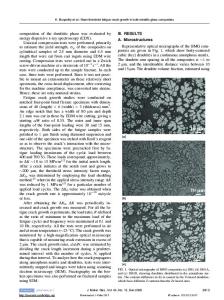Free Volume Changes and Crack Tip Deformation in Bulk Metallic Glass Alloys and their Composites
- PDF / 707,761 Bytes
- 12 Pages / 612 x 792 pts (letter) Page_size
- 34 Downloads / 382 Views
MM7.1.1
Free Volume Changes and Crack Tip Deformation in Bulk Metallic Glass Alloys and their Composites Biraja P. Kanungo, Matthew J. Lambert, and Katharine M. Flores Department of Materials Science and Engineering The Ohio State University Columbus, OH 43210-1178 ABSTRACT The free volume changes associated with deformation of metallic glasses play an important role in strain localization in shear bands. However the details of these structural changes during inhomogeneous deformation are unclear. In this study, the free volume changes in Cu60Zr30Ti10 and Zr58.5Cu15.6Ni12.8Al10.3Nb2.8 bulk metallic glasses were examined and quantified using differential scanning calorimetry following rolling and low temperature annealing. It was found that the height of the endothermic peak associated with the glass transition decreased following deformation whereas annealing resulted in an increase in the peak height. Additionally, the exothermic event associated with structural relaxation prior to the glass transition occurred at a lower temperature after rolling in the Zr-based system. Surprisingly, a similar shift in the onset temperature was not observed in the Cu-based system, suggesting a different structural relaxation mechanism. The Zr-based system was successfully modeled and the results indicated that the free volume increased ~4% with inhomogeneous deformation and decreased ~14% with annealing, consistent with expectations. In an effort to further characterize strain localization in shear bands, the development of a crack tip damage zone in a Zr-based bulk metallic glass composite was studied using scanning electron and atomic force microscopy. The first shear band developed at an angle of ~60° from the crack propagation direction. This is discussed in light of the Mohr-Coulomb yield criterion for metallic glasses. The reinforcement phase arrested the growth of individual shear bands, while accumulated damage resulted in the shear bands cutting through the crystalline phase, ultimately resulting in crack branching and failure. INTRODUCTION The development of bulk metallic glasses (BMGs) with minimum dimensions of several millimeters has resulted in renewed interest in the mechanical behavior of this unique class of materials [1-13]. At low temperatures and high strain rates, plastic flow is highly localized in shear bands. When these shear bands are unconstrained, such as under tensile loading conditions, strain localization results in catastrophic failure of the structure with very little macroscopic plastic deformation. However, the failure surfaces exhibit characteristic vein and void patterns indicative of significant softening on the failure plane. Thus, flow models that lead to strong softening in shear bands have been proposed. Argon introduced the concept of the shear transformation zone [14]. These zones begin as small regions where the local atomic structure is capable of rearrangement under an applied shear stress. The ability of a region to undergo a shear transformation depends on the local atomic density;
Data Loading...











